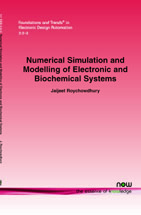Numerical Simulation and Modelling of Electronic and Biochemical Systems
By Jaijeet Roychowdhury, University of California, USA, jr@eecs.berkeley.edu
Abstract
Numerical simulation and modelling are witnessing a resurgence. Designing systems with integrated wireless components, mixed-signal blocks and nanoscale, multi-GHz "digital" circuits is requiring extensive low-level modelling and simulation. Analysis and design in nonelectronic domains, notably in systems biology, are also relying increasingly on numerical computation.
Sections 2–8 of this Monograph provide an introduction to the fundamentals of numerical simulation, and to the basics of modelling electronic circuits and biochemical reactions. The focus is on a minimal set of concepts that will enable the reader to further explore the field independently. Differential–algebraic equation models of electronic circuits and biochemical reactions, together with basic numerical techniques — quiescent, transient and linear frequency domain analyses, as well as sensitivity and noise analyses — for solving these differential equations are developed. Downloadable MATLAB implementations are provided.
The last two chapters provide an introduction to computational methods for nonlinear periodic steady states and multi-time partial differential equation (PDE) formulations, followed by an overview of model order reduction (MOR) and, at the end, a glimpse of some applications of oscillator MOR — in circuits (PLLs), biochemical reaction–diffusion systems and nanoelectronics.
Numerical Simulation and Modelling of Electronic and Biochemical Systems
Numerical simulation and modelling have been growing in importance and seeing steadily increasing practical application. The proliferation of applications and physical domains for which simulation technologies are now needed, compounded by generally increased complexity, has expanded the scope of numerical simulation and modelling within CAD and spurred new research directions. Numerical Simulation and Modelling of Electronic and Biochemical Systems provides an introduction to the fundamentals of numerical simulation, and to the basics of modelling electronic circuits and biochemical reactions. The emphasis is on capturing a minimal set of important concepts succinctly, but concretely enough that the reader will be left with an adequate foundation for further independent exploration. Starting from mathematical models of basic electronic elements, circuits are modelled as nonlinear differential-algebraic equation (DAE) systems. Two basic techniques - quiescent steady state and transient - for solving these differential equations systems are then developed. It is then shown how biochemical reactions can also be modelled deterministically as DAEs. Following this, frequency domain techniques for finding sinusoidal steady states of linear DAEs are developed, as are direct and adjoint techniques for computing parameter sensitivities and the effects of stationary random noise. For readers interested in a glimpse of topics beyond these basics, an introduction to nonlinear periodic steady state methods (harmonic balance and shooting) and the multitime partial differential equation formulation is provided. Also provided is an overview of model order reduction, an important topic of current research that has roots in numerical simulation algorithms. Finally, sample applications of nonlinear oscillator macromodels - in circuits (PLLs), biochemical reaction-diffusion systems and nanoelectronics - are presented.
